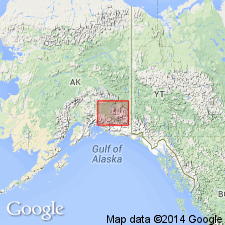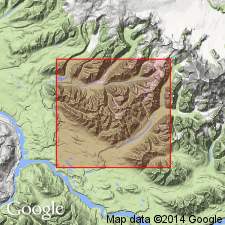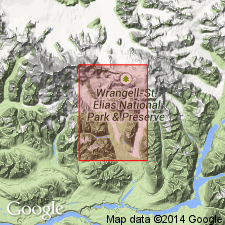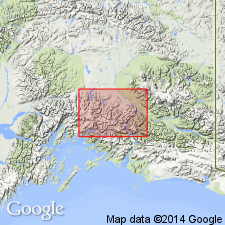
- Usage in publication:
-
- Nikolai greenstone*
- Modifications:
-
- Original reference
- Dominant lithology:
-
- Greenstone
- AAPG geologic province:
-
- Alaska Southern region
Summary:
Pg. 425-432. Nikolai greenstone. A series of greenstones that contain the Nikolai copper vein. Is a series of ancient basic volcanics, having appearance of extrusive flows, massive in some places, and in others somewhat amygdaloidal. Underlies Chiltstone limestone (new). Age is Silurian (corr. chart).
Occurs near Nikolai House on Nizina River, Nizina-Tanana region, southern AK.
Source: US geologic names lexicon (USGS Bull. 896, p. 1498); supplemental information from GNU records (USGS DDS-6; Menlo GNULEX).

- Usage in publication:
-
- Nikolai greenstone*
- Modifications:
-
- Revised
- Age modified
- AAPG geologic province:
-
- Alaska Southern region
Summary:
Nikolai greenstone of Rohn (1900). Described in Kotsina-Kuskulana district, Alaska. Thickness estimated to be about 6,500 feet. Age is Permian or Triassic based on stratigraphic relations. Underlying bedded volcanic rocks, now known to be older than Nikolai greenstone, are here separated as Mississippian Strelna formation (new).
Source: Modified from GNU records (USGS DDS-6; Menlo GNULEX).

- Usage in publication:
-
- Nikolai greenstone*
- Modifications:
-
- Age modified
- AAPG geologic province:
-
- Alaska Southern region
Summary:
Later work showed that typical Nikolai greenstone as defined by Rohn is of Permian and possibly Triassic age, but that in many subsequent reports the name was used to include the Mississippian tuffs, basalts, and interbedded shale, chert, and limestone which have been named Strelna formation. The name is now restricted to the Permian (and possibly Triassic) rocks to which it was originally applied.
Source: US geologic names lexicon (USGS Bull. 896, p. 1498).

- Usage in publication:
-
- Nikolai Greenstone*
- Modifications:
-
- Age modified
- AAPG geologic province:
-
- Alaska Southern region
Summary:
Nikolai Greenstone. Age is given as late Middle and (or) early Late Triassic. Described as mainly dark greenish-gray to greenish-brown basalt in flows 2 to 30 feet thick, commonly amygdaloidal, partly chloritized.
Source: GNU records (USGS DDS-6; Menlo GNULEX).

- Usage in publication:
-
- Nikolai Greenstone*
- Modifications:
-
- Areal extent
- AAPG geologic province:
-
- Alaska Southern region
Summary:
Nikolai Greenstone. Geographically extended into Valdez quadrangle (Domain I) east of Tara fault. Age is Middle and (or) Late Triassic.
Source: GNU records (USGS DDS-6; Menlo GNULEX).

- Usage in publication:
-
- Nikolai Greenstone*
- Modifications:
-
- Age modified
- AAPG geologic province:
-
- Alaska Southern region
Summary:
Nikolai greenstone. Age of unit in area of report (southern part of Mount Hayes quadrangle [and also in Healy A-1 quadrangle]) is considered Late Triassic based on occurrence of pelecypod DAONELLA or HALOBIA. [Unit age elsewhere (in McCarthy quadrangle) remains Middle and (or) Late Triassic.]
Source: GNU records (USGS DDS-6; Menlo GNULEX).
For more information, please contact Nancy Stamm, Geologic Names Committee Secretary.
Asterisk (*) indicates published by U.S. Geological Survey authors.
"No current usage" (†) implies that a name has been abandoned or has fallen into disuse. Former usage and, if known, replacement name given in parentheses ( ).
Slash (/) indicates name conflicts with nomenclatural guidelines (CSN, 1933; ACSN, 1961, 1970; NACSN, 1983, 2005, 2021). May be explained within brackets ([ ]).

